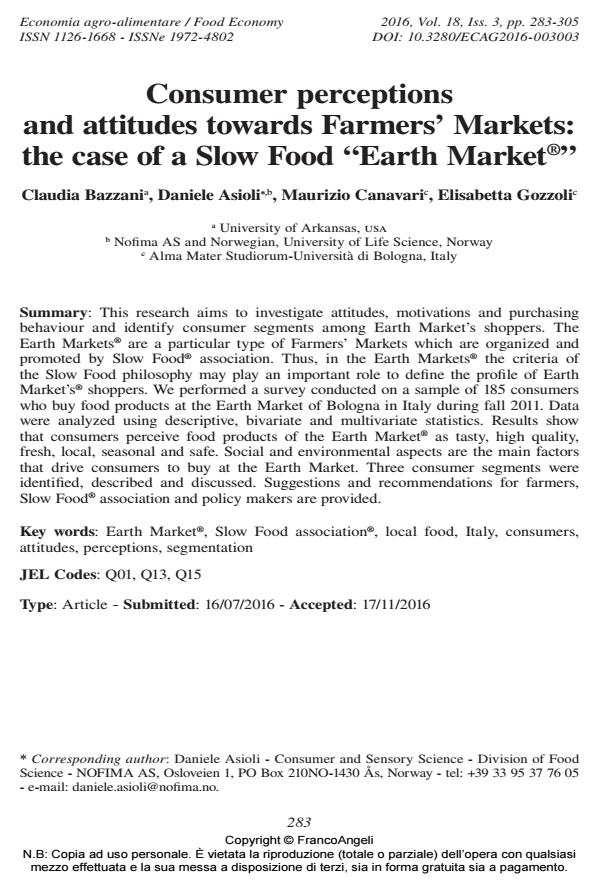Consumer perceptions and attitudes towards Farmers' Markets: the case of a Slow Food "Earth Market"®
Journal title ECONOMIA AGRO-ALIMENTARE
Author/s Claudia Bazzani, Daniele Asioli, Maurizio Canavari, Elisabetta Gozzoli
Publishing Year 2017 Issue 2016/3
Language English Pages 20 P. 283-302 File size 155 KB
DOI 10.3280/ECAG2016-003003
DOI is like a bar code for intellectual property: to have more infomation
click here
Below, you can see the article first page
If you want to buy this article in PDF format, you can do it, following the instructions to buy download credits

FrancoAngeli is member of Publishers International Linking Association, Inc (PILA), a not-for-profit association which run the CrossRef service enabling links to and from online scholarly content.
This research aims to investigate attitudes, motivations and purchasing behaviour and identify consumer segments among Earth Market`s shoppers. The Earth Markets® are a particular type of Farmers' Markets which are organized and promoted by Slow Food® association. Thus, in the Earth Markets® the criteria of the Slow Food philosophy may play an important role to define the profile of Earth Market’s® shoppers. We conducted a survey on a sample of 185 consumers who buy food products at the Earth Market of Bologna in Italy during fall 2011. Data were analyzed using descriptive, bivariate and multivariate statistics. Results show that consumers perceive food products of the Earth Market® as tasty, high quality, fresh, local, seasonal and safe. Social and environmental aspects are the main factors that drive consumers to buy at the Earth Market. Three consumer segments were identified, described and discussed. Suggestions and recommendations for farmers, Slow Food® association and policy makers are provided.
Keywords: Earth Market®; Slow Food association®; local food; Italy; consumers; attitudes; segmentation.
Jel codes: Q01, Q13, Q15
- Guest editorial. Revisiting the Slow Food Movement: Three Cases of Heritage, Innovation, and Sustainability in Alternative Food Networks Luca Cacciolatti, Soo Hee Lee, Giovanna Sacchi, Jinha Lee, in Economia agro-alimentare 2/2024 pp.83
DOI: 10.3280/ecag2024oa18190
Claudia Bazzani, Daniele Asioli, Maurizio Canavari, Elisabetta Gozzoli, Consumer perceptions and attitudes towards Farmers' Markets: the case of a Slow Food "Earth Market"® in "ECONOMIA AGRO-ALIMENTARE" 3/2016, pp 283-302, DOI: 10.3280/ECAG2016-003003